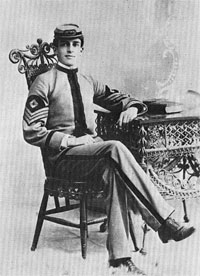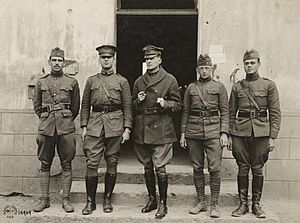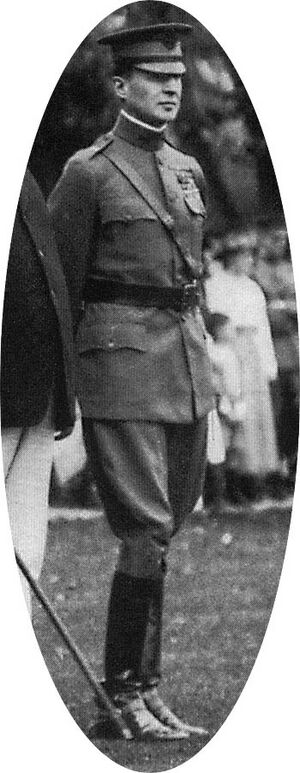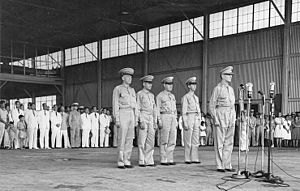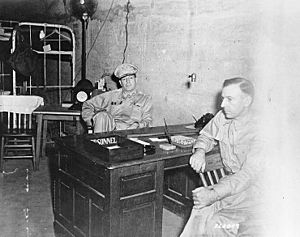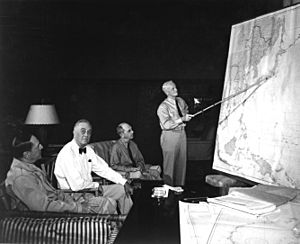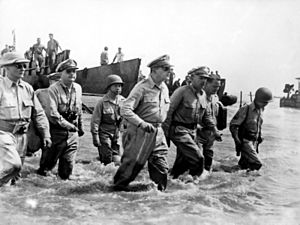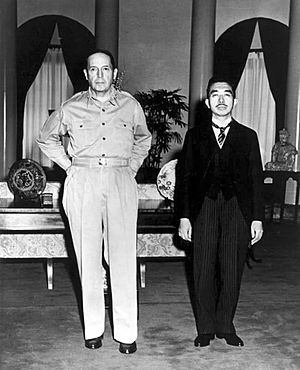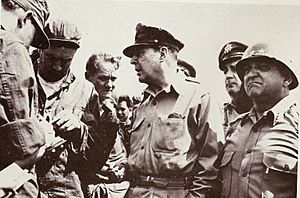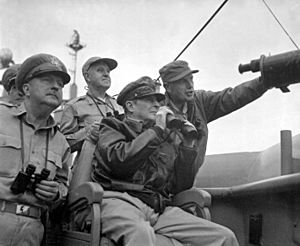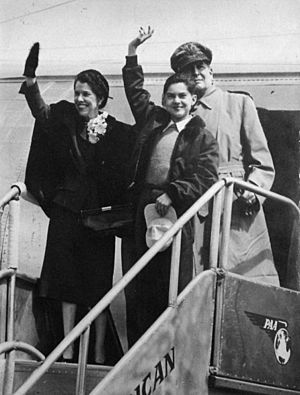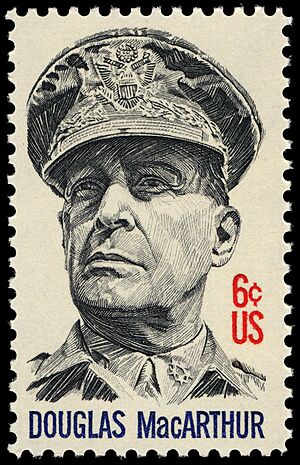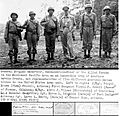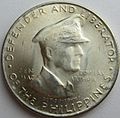Douglas MacArthur facts for kids
Quick facts for kids
Douglas MacArthur
|
|
|---|---|
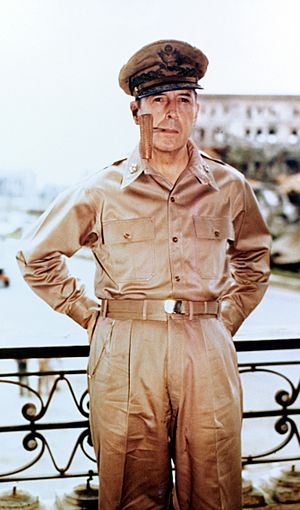
MacArthur in 1945
|
|
| Governor of the Ryukyu Islands | |
| In office 15 December 1950 – 11 April 1951 |
|
| Preceded by | Position established |
| Succeeded by | Matthew Ridgway |
| Commander of the United Nations Command | |
| In office 7 July 1950 – 11 April 1951 |
|
| President | Harry S. Truman |
| Preceded by | Position established |
| Succeeded by | Matthew Ridgway |
| Commander of the Far East Command | |
| In office 1 January 1947 – 11 April 1951 |
|
| President | Harry S. Truman |
| Preceded by | Position established |
| Succeeded by | Matthew Ridgway |
| 1st Supreme Commander for the Allied Powers | |
| In office 14 August 1945 – 11 April 1951 |
|
| President | Harry S. Truman |
| Preceded by | Position established |
| Succeeded by | Matthew Ridgway |
| United States Military Advisor to the Philippines | |
| In office 1935–1941 |
|
| Preceded by | Position established |
| Succeeded by | Position abolished |
| 13th Chief of Staff of the Army | |
| In office 21 November 1930 – 1 October 1935 |
|
| President | |
| Preceded by | Charles P. Summerall |
| Succeeded by | Malin Craig |
| Commander of the Philippine Department | |
| In office 1 October 1928 – 2 October 1930 |
|
| Preceded by | William Lassiter |
| Succeeded by | John L. Hines |
| 16th Superintendent of the United States Military Academy | |
| In office 1919–1922 |
|
| Preceded by | Samuel Escue Tillman |
| Succeeded by | Fred Winchester Sladen |
| Personal details | |
| Born | 26 January 1880 Little Rock, Arkansas, U.S. |
| Died | 5 April 1964 (aged 84) Washington, D.C., U.S. |
| Resting place | MacArthur Memorial |
| Political party | Republican |
| Spouses |
|
| Children | Arthur |
| Parent |
|
| Relatives | MacArthur family |
| Education | United States Military Academy |
| Civilian awards | |
| Signature | |
| Nicknames |
|
| Military service | |
| Allegiance |
|
| Branch/service |
|
| Years of service | 1903–1964 |
| Rank |
|
| Commands |
|
| Battles/wars |
List of battles/wars
|
| Military awards |
|
Douglas MacArthur (born January 26, 1880 – died April 5, 1964) was a famous American military leader. He became a General of the Army for the United States and also a field marshal for the Philippine Army. He fought bravely in World War I, was the Chief of Staff of the United States Army in the 1930s, and played a very important role in the Pacific theater during World War II.
MacArthur was nominated for the Medal of Honor three times. He finally received it for his service in the Philippines campaign. This made him and his father, Arthur MacArthur Jr., the first father and son to both receive this high award. He was one of only five men to reach the rank of General of the Army in the U.S. Army. He was also the only person to be given the rank of field marshal in the Philippine Army.
Douglas MacArthur grew up in a military family. He was the best student at the West Texas Military Academy and later at the United States Military Academy at West Point. He graduated at the top of his class in 1903.
Contents
Early Life and Military Start
Douglas MacArthur was born on January 26, 1880, in Little Rock, Arkansas. His father, Arthur MacArthur Jr., was a U.S. Army captain who later became a lieutenant general and also received the Medal of Honor. Douglas was the youngest of three sons. His family moved often to different Army posts. He learned to ride and shoot at a young age.
MacArthur attended the West Texas Military Academy where he was an excellent student and athlete. He then entered West Point, the U.S. Military Academy, in 1899. He was a top student and graduated first in his class in 1903. He became a second lieutenant in the United States Army Corps of Engineers.
His first assignment was in the Philippines in 1903, where he worked on building projects. He later served as an aide to his father, who was stationed in Japan and traveled through Asia.
Veracruz Expedition
In 1914, the U.S. occupied Veracruz, Mexico. MacArthur joined the headquarters staff there. He went on a dangerous mission to find locomotives for the railroad. During this mission, he faced armed men and was shot at, but he was not hurt. His bravery was noted, and he was nominated for the Medal of Honor, but he did not receive it at that time.
World War I Heroics
In 1915, MacArthur was promoted to major. When the U.S. entered World War I in 1917, he helped create the 42nd ("Rainbow") Division. This division was made up of units from different states. MacArthur became its chief of staff with the rank of colonel. He asked to be in the infantry, not the engineers.
The 42nd Division trained in New York and then sailed to France in October 1917.
Fighting on the Western Front
In February 1918, the 42nd Division entered the front lines in France. MacArthur showed great bravery during a trench raid and was awarded the French Croix de Guerre. He also received a Silver Star for his actions. He was gassed during the fighting but recovered quickly.
MacArthur was promoted to brigadier general in June 1918. He continued to lead his troops with courage, earning more Silver Stars and other honors. French General Henri Gouraud praised MacArthur as "one of the finest and bravest officers I have ever served with."
During the Meuse–Argonne offensive, MacArthur was wounded but not severely. He personally led a dangerous scouting mission into "no man's land" at night. He was the only survivor of this patrol, which confirmed a weak spot in the German defenses. For his bravery, he received another Distinguished Service Cross.
On November 10, 1918, just before the war ended, MacArthur was appointed commander of the 42nd Division. For his service, he received the Army Distinguished Service Medal.
Between the World Wars
Leading West Point
From 1919 to 1922, MacArthur served as the Superintendent of the U.S. Military Academy at West Point. He was the youngest superintendent since 1817. He aimed to modernize the academy, which he felt was outdated.
MacArthur wanted officers to understand more than just military science. He brought back the four-year course and expanded the idea of military character to include leadership and athletic performance. He also formalized the Cadet Honor Code. He tried to update the courses to include more liberal arts and modern history. He also increased sports programs and allowed cadets more freedom. Many of his changes were not popular at first but were later adopted.
Rising Through the Ranks
In 1922, MacArthur moved to the Philippines to command the Military District of Manila. He became friends with Filipino leaders like Manuel L. Quezon. In 1924, he helped calm a mutiny among the Philippine Scouts. In 1925, at age 44, he became the Army's youngest major general.
MacArthur served as president of the American Olympic Committee for the 1928 Summer Olympics in Amsterdam. In 1929, while he was in Manila, his first wife, Louise, divorced him.
Chief of Staff of the Army
In 1930, MacArthur became the Chief of Staff of the United States Army, reaching the rank of general. During this time, the Great Depression led to budget cuts for the Army. MacArthur worked to prevent major reductions in military personnel. He also helped develop new plans for how the Army would respond in a crisis.
One challenging event was the "Bonus Army" protest in 1932. Thousands of World War I veterans marched on Washington, D.C., asking for early payment of their bonuses. President Herbert Hoover ordered MacArthur to clear the area. MacArthur led troops, using tear gas to disperse the protesters. This event was controversial and hurt his public image for a time.
MacArthur also supported the Civilian Conservation Corps, a program that put unemployed young men to work on public projects. He believed in a strong military and often spoke out against ideas of pacifism.
In 1935, MacArthur's term as Chief of Staff ended. He received a second Distinguished Service Medal. He also received two Purple Hearts for his World War I service, a medal he had helped bring back.
Field Marshal in the Philippines
In 1935, the Philippine Commonwealth became semi-independent. Philippine President Manuel Quezon asked MacArthur to help create a Philippine Army. MacArthur accepted and was given the rank of field marshal in the Philippine Army, making him the highest-paid soldier in the world.
MacArthur worked to train the new army, but they faced challenges with old equipment and limited funds. In 1937, MacArthur retired from the U.S. Army but stayed on as Quezon's military advisor. He married Jean Faircloth in 1937, and their son, Arthur, was born in Manila in 1938.
World War II Leadership
Defending the Philippines (1941-1942)
In July 1941, with war approaching, President Franklin D. Roosevelt called MacArthur back to active duty. He was made commander of U.S. Army Forces in the Far East (USAFFE) and quickly promoted to general. MacArthur planned to defend all of Luzon and use bombers to stop Japanese ships.
On December 8, 1941 (local time), Japan attacked Pearl Harbor. Hours later, Japanese planes attacked U.S. airfields in the Philippines, destroying many aircraft. MacArthur's forces were soon forced to retreat to the Bataan peninsula. Manila was declared an open city to prevent its destruction.
MacArthur moved his headquarters to the island fortress of Corregidor. The Japanese bombed the island, forcing the headquarters into the Malinta Tunnel. The American and Filipino troops on Bataan fought bravely despite being cut off from supplies.
In March 1942, President Roosevelt ordered MacArthur to leave the Philippines and go to Australia. MacArthur, his family, and staff escaped by PT boat and then by plane. When he arrived in Australia, he famously declared, "I came through and I shall return." Bataan surrendered in April and Corregidor in May.
Medal of Honor for Philippines Defense
General George Marshall decided that MacArthur should receive the Medal of Honor for his leadership in defending the Philippines. This was to boost morale and counter enemy propaganda. MacArthur accepted the award, saying it recognized the courage of his troops. He and his father were the first father and son to receive this medal.
Leading in the Southwest Pacific
On April 18, 1942, MacArthur became the Supreme Allied Commander for the South West Pacific Area (SWPA). He worked closely with Australian Prime Minister John Curtin. His headquarters moved to Brisbane, Australia.
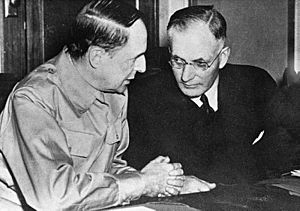
MacArthur's forces, mostly Australian and American, began fighting the Japanese in New Guinea. The Japanese landed at Buna and Milne Bay. Australian forces successfully pushed back the Japanese at Milne Bay. The fighting in New Guinea was very tough, especially in the Battle of Buna–Gona. MacArthur sent more American troops and pushed his commanders to win.
Island Hopping Towards Japan
MacArthur's strategy was to "island hop," bypassing strong Japanese bases and attacking weaker ones. This saved lives and time. For example, he bypassed Japanese forces at Hansa Bay and Wewak and attacked Hollandia and Aitape. This surprised the Japanese and cut off their troops.
In July 1944, President Roosevelt met with MacArthur in Hawaii to discuss the next steps. MacArthur argued strongly for liberating the Philippines, saying America had a moral duty to return. Roosevelt agreed.
Returning to the Philippines (1944-1945)
On October 20, 1944, MacArthur's troops landed on Leyte in the Philippines. MacArthur famously waded ashore, fulfilling his promise, "I shall return." This moment was captured in an iconic photograph.
The fighting on Leyte was difficult due to heavy rains and strong Japanese resistance. On December 18, 1944, MacArthur was promoted to the new five-star rank of General of the Army.
Next, MacArthur planned the invasion of Luzon. His main goal was to capture Manila and its important port and airfields. The Battle of Manila was fierce, lasting three weeks. MacArthur tried to protect civilians by limiting air strikes, but many still died.
MacArthur also ordered daring rescue missions to free Allied prisoners of war and civilians held in Japanese camps, such as Cabanatuan and Santo Tomas.
After Manila was taken, MacArthur focused on the remaining Japanese forces in northern Luzon. Although the fighting continued, MacArthur announced on July 5, 1945, that the Philippines had been liberated. He also used Australian troops for the invasion of Borneo.
As part of the plans for invading Japan, MacArthur became commander of all U.S. Army forces in the Pacific in April 1945. The war ended when Japan surrendered in August 1945. On September 2, MacArthur officially accepted Japan's surrender aboard the battleship USS Missouri in Tokyo Bay. For his role as a naval strategist, he received the Navy Distinguished Service Medal.
Rebuilding Japan
Supreme Commander for the Allied Powers
After the war, MacArthur became the Supreme Commander for the Allied Powers (SCAP) in Japan. He was in charge of rebuilding the country. His goal was to help Japan become a peaceful, democratic nation. He worked through the existing Japanese government, including the Emperor Hirohito.
MacArthur decided to keep the Emperor as a symbol, but without real power. This helped keep order during the occupation. A famous photo of MacArthur and Emperor Hirohito showed the Emperor as a normal man, which was a big change for the Japanese people who had seen him as a living god.
In 1946, MacArthur's staff helped write a new Japanese constitution. This constitution stated that Japan would never go to war again and would not have a standing army. It also gave women the right to vote, guaranteed human rights, and created a democratic government.
MacArthur also oversaw major land reforms, giving land to farmers who worked it. He encouraged trade unions, which grew very quickly. He also ordered the release of political prisoners and allowed the Japanese Communist Party to participate in elections, showing his commitment to democracy.
MacArthur was also in charge of southern Korea from 1945 to 1948. He appointed Lieutenant General John R. Hodge to govern the area.
In 1948, MacArthur considered running for U.S. president, but he did not actively campaign. He hoped to be chosen as a compromise candidate, but he was not nominated. He handed over most power to the Japanese government in 1949 but remained in Japan until 1951. The San Francisco Peace Treaty in 1951 officially ended the Allied occupation. The Japanese later nicknamed him Gaijin Shogun (Foreigner General).
The Korean War
Early Battles and Inchon Landing
On June 25, 1950, North Korea invaded South Korea, starting the Korean War. The United Nations Security Council quickly authorized a United Nations Command (UNC) force to help South Korea. MacArthur was chosen as the commander-in-chief of the UNC.
The North Koreans pushed South Korean and U.S. forces back to the Pusan Perimeter. MacArthur planned a daring amphibious landing at Inchon, far behind enemy lines. This was a risky move, but it worked.
In September 1950, MacArthur's forces landed at Inchon. This surprise attack outflanked the North Koreans, allowing UN forces to recapture Seoul and force the enemy to retreat. MacArthur visited the battlefield, showing his courage by ignoring sniper fire.
The UN then authorized MacArthur to advance beyond the 38th parallel into North Korea to unify Korea. MacArthur planned another landing at Wonsan, but South Korean troops captured it first. In October, MacArthur met with President Harry S. Truman at the Wake Island Conference. Truman awarded him his fifth Distinguished Service Medal.
China Enters the War
In late October 1950, UN forces encountered Chinese soldiers in Korea. China had secretly sent troops to help North Korea. MacArthur's intelligence staff underestimated the number of Chinese troops.
On November 25, 1950, the Chinese Army launched a massive attack, forcing UN forces into a long retreat. Seoul fell again in January 1951.
MacArthur's Removal
As UN forces pushed north again, Truman saw a chance for peace talks. However, on March 24, MacArthur publicly challenged China and his own superiors, calling for victory. This went against Truman's policy of a limited war.
On April 5, 1951, a letter from MacArthur criticizing Truman's policies was read in Congress. Truman felt MacArthur was being disobedient and decided to remove him from command. On April 11, Truman relieved MacArthur of all his commands.
This decision caused a huge public debate. Many Americans supported MacArthur, who was a war hero. However, Truman and his advisors believed MacArthur's actions could lead to a larger war with China and possibly the Soviet Union.
Later Life and Legacy
After his removal, MacArthur returned to the United States. On April 19, 1951, he gave a famous farewell address to the U.S. Congress, defending his actions. He received many ovations.
MacArthur was greeted by huge crowds across the country. There were hopes he would run for president, but he did not. He continued to speak out against the Truman administration's policies.
Douglas and Jean MacArthur spent their later years in New York City. MacArthur became chairman of the board of Remington Rand, a business company. In 1961, he made a "sentimental journey" back to the Philippines, where he was welcomed by millions of cheering people.
President John F. Kennedy and later President Lyndon B. Johnson sought MacArthur's advice. MacArthur cautioned them against getting deeply involved in a land war in Asia, like in Vietnam. He advised Kennedy on the Cuban Missile Crisis, suggesting a naval blockade.
In 1962, West Point honored MacArthur with the Sylvanus Thayer Award. He also received the Thanks of Congress and the Congressional Gold Medal for his service.
Douglas MacArthur died on April 5, 1964, at age 84. He was given a state funeral and buried at the Douglas MacArthur Memorial in Norfolk, Virginia, where his mother was born. The memorial now houses a museum about his life.
MacArthur remains a very important and sometimes debated figure in American history. He is seen as a hero in the Philippines and South Korea for his role in their liberation and defense. He was known for his bold strategies and leadership.
Honors and Awards
During his long career, Douglas MacArthur received over 100 military decorations from the U.S. and other countries. These include the Medal of Honor, the French Légion d'honneur, and the Japanese Order of the Rising Sun.
He was very popular with the American public, and many things were named after him. Since 1987, the U.S. Army gives out the General Douglas MacArthur Leadership Awards to recognize outstanding young officers. There are also MacArthur Cadet Awards for military school students and MacArthur Awards for top ROTC programs.
Portrayals
Many actors have played Douglas MacArthur in movies and TV shows:
- Dayton Lummis in The Court-Martial of Billy Mitchell (1955)
- Henry Fonda in Collision Course: Truman vs. MacArthur (1976)
- Gregory Peck in MacArthur (1977)
- Laurence Olivier in Inchon (1981)
- Tommy Lee Jones in Emperor (2012)
- Liam Neeson in Operation Chromite (2016)
Images for kids
-
General Pershing (second from left) decorates Brigadier General MacArthur (third from left) with the Distinguished Service Cross.
-
Senior Allied commanders in New Guinea in October 1942. Left to right: Mr Frank Forde (Australian Minister for the Army); MacArthur; General Sir Thomas Blamey, Allied Land Forces; Lieutenant General George C. Kenney, Allied Air Forces; Lieutenant General Edmund Herring, New Guinea Force; Brigadier General Kenneth Walker, V Bomber Command.
-
American military officers off Leyte Island in the Philippines, October 1944.
-
MacArthur was the subject of two different legal tender commemorative coins in the Philippines in 1947.
-
MacArthur speaking at Soldier Field in Chicago in 1951.
-
Tomb of Douglas and Jean MacArthur at the MacArthur Memorial in Norfolk.
See also
 In Spanish: Douglas MacArthur para niños
In Spanish: Douglas MacArthur para niños


